Manchester United – Arsenal 1:2
Arsene Wenger left Manchester with a deserved victory to progress into the semi-final of the FA cup, following a strong performance against a poor opposition in Manchester United.
Line Ups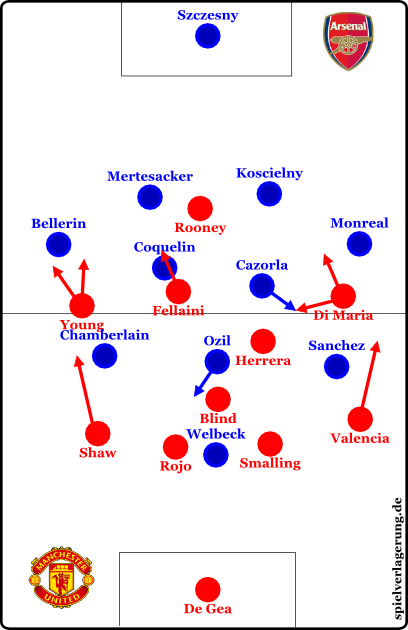
For the home side, the outstanding David De Gea was the goalkeeper, ‘protected’ by a back four of Shaw and Valencia flanking centre-backs Rojo and Chris Smalling. Daley Blind played as a lone pivot behind a central partnership of Fellaini and Ander Herrera. Angel Di Maria and Ashley Young were on the touchlines, looking to support Wayne Rooney as the lone striker.
Wenger’s team lined up in a standard 4-2-3-1, led by ex-United Danny Welbeck. Szczesny started as the ‘cup goalkeeper’ behind Hector Bellerin, Per Mertesacker, Koscielny and Monreal. Santi Cazorla joined Coquelin in the central midfield with a 3 of Alexis Sanchez, Mesut Ozil and Oxlade-Chamberlain ahead of them, supporting the aforementioned Welbeck up top.
Arsenal pressing
As expected, Arsenal had quite a focus on Daley Blind during United’s 1st phase, as the Dutchman is key to his side’s circulation in bringing the ball out of the defence. He was often crowded with Ozil and situationally at times of more stable possession, Welbeck too (otherwise he would be pressing the nervous Rojo and Smalling). In reaction, the ex-Ajax midfielder made more dropping movements and at times sat in the left half space, where the Arsenal forwards were reluctant to press. However, he couldn’t impact the game very well from here, especially with the aforementioned opposition pressers blocking passes into midfield, which was often disconnected from the foundation.
Overall they were rather man-oriented, especially in wide areas with Sanchez and Chamberlain focused on their respective opposition full-back. Meanwhile, the midfield was also difficult for United to pass through with both 8s being covered by Coquelin and Cazorla.
Arsenal Low Block
In this game, we saw a similar low-block as to the one that Wenger utilised against Manchester City. However, at Old Trafford this was used exclusively in the third phase, in contrast to the previous Manchester game where it was used as a more overall strategy against the ball.
A key difference in the opposition between the two mentioned games, was that United were equipped with a target man in Marouane Fellaini. The Belgian could be used to counteract and exploit Arsenal’s deep defensive line and lack of pressure in higher areas, which was highlighted in Rooney’s first half goal. In the 10 minutes building up to the goal, a similar pass from Di Maria to Fellaini at the back post was used quite frequently, so at the time of the goal, Mertesacker was drawn to here expecting the same. The gap between the two centre-backs was gaping and Rooney capitalised after an excellent ball by his Argentine teammate.
Against Manchester United, Wenger was probably looking to emphasise United’s poor possession game and lack of ability to destabilise the opposition, which worked to some extent. However, with Fellaini on the opposition, it could be argued that this was less effective an approach, given United’s alternative which City didn’t have.
United’s Poor Possession Game
Overall, United were poor in possession as they have shown in many games in Van Gaal’s first season in charge.
In the first phase, they struggled to develop the ball out of the defence, with the key player Blind nearly always covered whilst neither Rojo nor Smalling displayed the ability to provide alternative support. In reaction, Herrera dropped situationally to support the developments but was unable to receive the ball due to simple man-marking most of the time. In contrast, Fellaini rarely supported directly in the deep possession, and instead was often the joint-highest United player alongside Rooney. As a result, especially with the full-backs poor involvement, the first phase was often disconnected and as a result they struggled to progress the ball.
During the second phase, the home side faced similar issues. They struggled to develop their possession game and were often forced to wider developments, which were much less threatening. There were also too many situations in which the home side resorted to long balls to Fellaini, which albeit were effective at times, resulted in a predictable and one-dimensional attack. Di Maria often made inside movements on around the same line as Daley Blind in these situations, however due to Arsenal’s low block, with man orientations in midfield, he rarely could open a passing lane and had to resort to square balls often to the other wing, or at most cross-field switches to Ashley Young which were easily dealt with.
Overall their possession game struggled, especially in central areas where they carried little threat. This was because their positional play was quite oriented on wide attacks, as Fellaini was high alongside Rooney meaning he wasn’t getting in positions to support possession, leaving at times only Herrera in a central position in midfield (with Blind much deeper) and obviously he couldn’t create on his own against Arsenal’s low block.
They were also quite wing oriented but more so on the left flank, which was presumably as a reaction to Arsenal’s Bellerin obtaining an early yellow card. This likely contributed to Di Maria’s lack of contribution in United’s possession, as play was not often through the Argentine.
United’s Defensive Instability
A key aspect of the game was United’s defensive performance.
Especially in the first phase, United were quite imbalanced, as the left side pressed higher than on the right, resulting in an asymmetrical structure which was easily exploited. This was especially the key given that the best player on the pitch – Alexis Sanchez – was positioned on this weaker side.
Through this imbalance, Arsenal created a number of situations in which they could exploit the qualitative superiority of Sanchez against Valencia, whilst Angel Di Maria’s support was often lacking.
Their right-sided weakness was exposed for the opening goal of the game. Ozil broke away from a right combination with Monreal after he initially moved to this flank. At this point, the right half space was open significantly as United were very poorly compact horizontally with significant distances between the midfield.
In the build-up towards the opening goal, Herrera and Fellaini took up poor defensive positioning, both in the ball-near half-space which left Daley Blind having to cover a very difficult amount of space. A rather simple switch to the inside half-space highlighted this issue, as Ozil had easily enough space to pick out Chamberlain who assisted Monreal.
Given some poor support off of the ball by Welbeck, Ozil was forced to make a small switch to Chamberlain which was seemingly quite difficult as it had to pass a few red shirts on the way. Nevertheless, the winger received the ball and made an excellent dribble across the edge of the box, back to United’s right side where Monreal was free after Di Maria had suffered a lapse in concentration.
Daley Blind was quite strictly oriented on Mesut Ozil, to the extent of following quite far out of his original 10 position. This is something that the German did quite frequently to case temporary instability in United’s defence, especially since the space wasn’t covered by his teammates.
The Dutchman was often lacking in support from the two 8s in particular ahead of his defensive midfield position. This was always going to be an important space for United to control, as Arsenal had Ozil in this space and was often joined by the inside movements of Oxlade-Chamberlain and Sanchez, whilst Cazorla situationally moved ahead of the ball also.
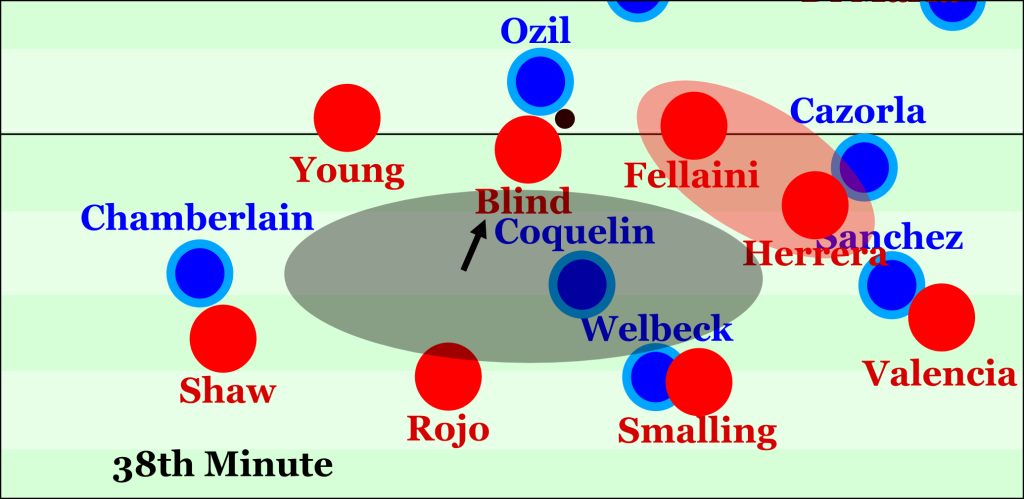
The 10 space was often open as a result of Blind having to move up when the central midfielders had poor positions, as shown here.
The two 8s were also quite oriented on their Arsenal counterparts, with Fellaini covering Coquelin and Herrera on Cazorla. The former case was quite interesting, as it allowed the Belgian to stay very high to support Rooney in attacking transition. It’s quite difficult to deduce which was the cause and which the effect. Though I’m led to believe that Coquelin stayed back partly in insurance against Fellaini, who quite often stays high upfield, though I think his freedom in this was supported by the lack of attacking movement from Arsenal’s holder.
Cazorla was able to exploit the man-orientations through concise movement off of the ball, which at times Ander Herrera struggled to deal with. This was especially the case in movements towards the left flank, which in combination with Fellaini’s high positioning, meant that Blind was significantly exposed. There was an instance of this in the build-up to the opening goal of the game.
United also showed weakness in their defensive transition following Arsenal regaining possession in United’s 1st or 2nd phases. This was a result of their poor connections between the foundation and midfield block, which not only was resulting in them losing possession often, but caused defensive weakness for Arsenal to use following this. With Fellaini high centrally and Young not supporting inside, this was especially the case on the left side, as only Herrera could support the progression into phase 2 from the middle of the pitch.
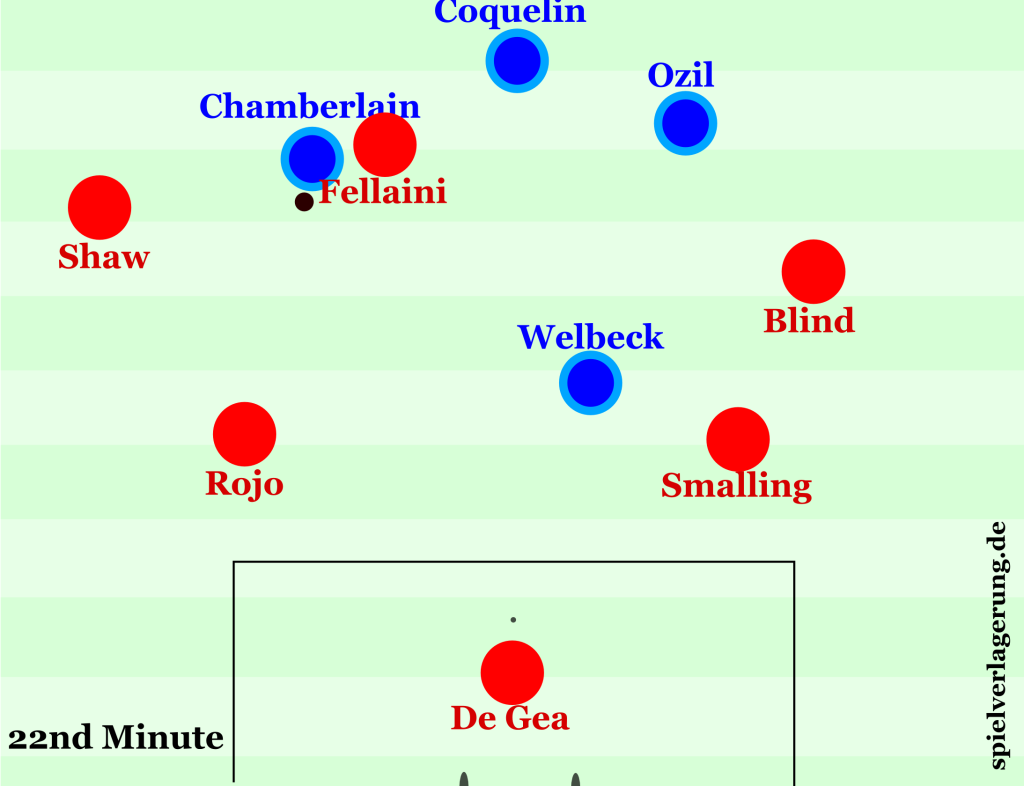
Here shows an instance of United’s instability in defensive transition – the positional game was quite expansive especially centrally, leaving them open to counters.
Conclusion
In summary, the game was yet another in quite a number this season in which Manchester United’s shortfalls in possession were on display. However, I feel that Arsenal did well to emphasize this weakness, with a fairly strong defensive performance (for the standards of the English top flight) and did well to nullify the key players of Van Gaal’s team on the ball.
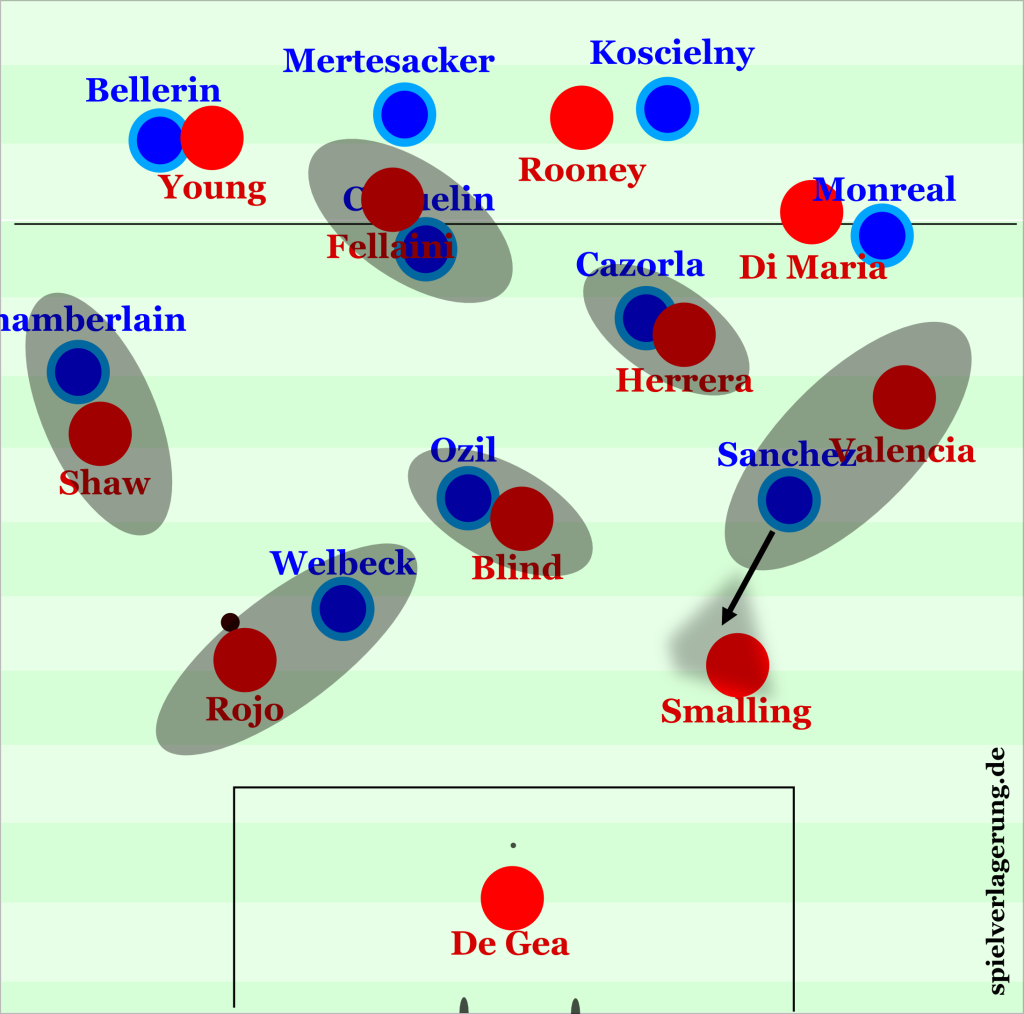
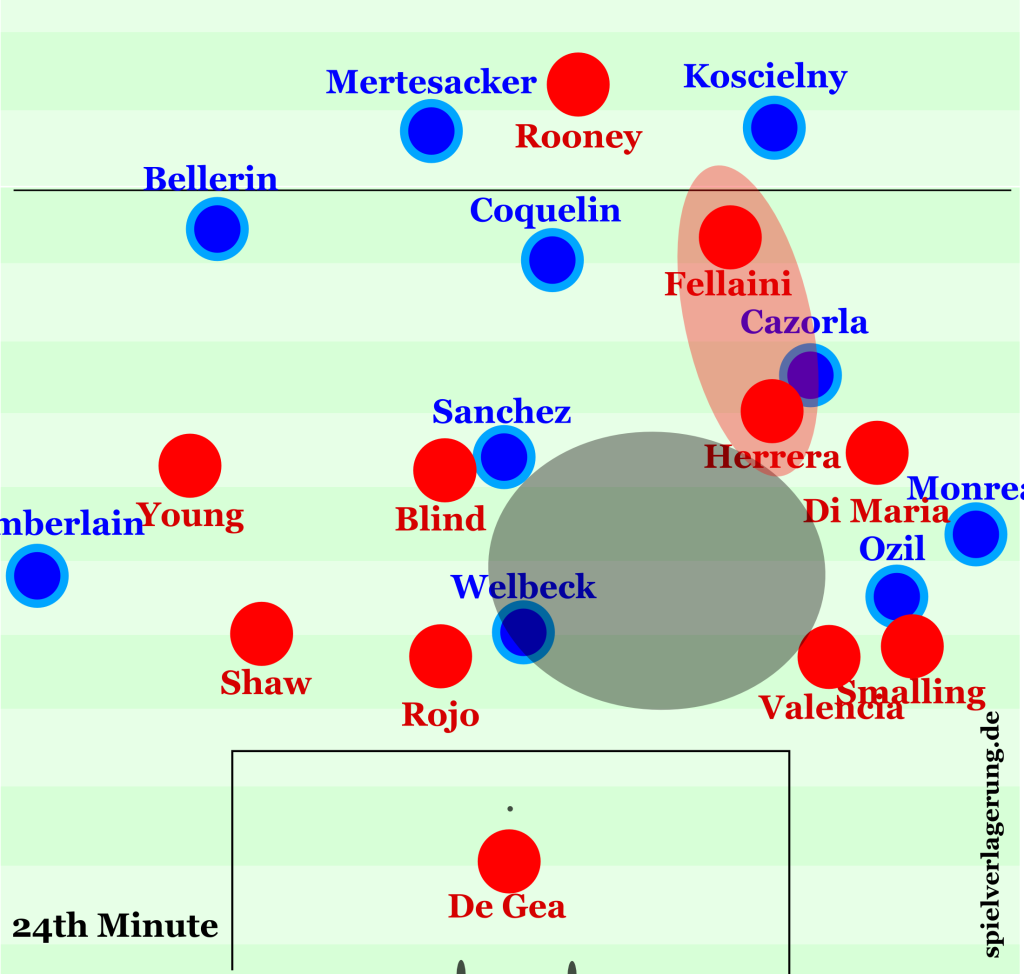
4 Kommentare Alle anzeigen
Judah Davies March 12, 2015 um 9:30 pm
Bit harsh on United don’t you think Tom?
I mean I know we weren’t great but I don’t think Arsenal were either and to say we didn’t threaten much is a bit of an exaggeration given that Fellaini, Young, Di maria (2/3 times) and Smalling all had very easy chances that they could have scored. Lastly to say that De Gea kept us in the match reflects how Arsenal worked him AFTER the red card (eg Cazorla and Sanchez). On the whole can you really say Arsenal deserved to win especially considering that we gifted them the goal/win??
Judah: https://footballtactics1415.wordpress.com/
Ben March 11, 2015 um 12:38 pm
Great read, thanks! Regarding ManU’s orientation towards the wings, whilst I think you are right to point out they tried to expose Bellerín, would you not agree that, nevertheless, they looked much more dangerous attacking down their right flank?
Bellerín supported by Chamberlain and later Chambers supported by Özil, I felt, were very effective shutting down anything that came down their flank, whereas on the other side of the pitch di María in particular was afforded much more space. Alexis made life much harder here for Monreal because he was not as disciplined as the rest of the team dropping back and simply restricting space, but rather often went straight for whoever was on the ball, which left a gaping hole just before the back line. That’s how di María could play those very precise services to the box, and that’s why United suffered doubly when he was sent off.
TP March 11, 2015 um 5:56 pm
Thanks mate!
Yeah I’d agree, overall I don’t think United threatened much really, but they were more threatening on the right than anywhere else. The differences in quality and roles between Di Maria and Young must be highlighted in this also.
George Thomas March 10, 2015 um 11:59 pm
Another very interesting read, makes you think about the game a lot more, explains Man United’s high possession stat but lack of chances created.